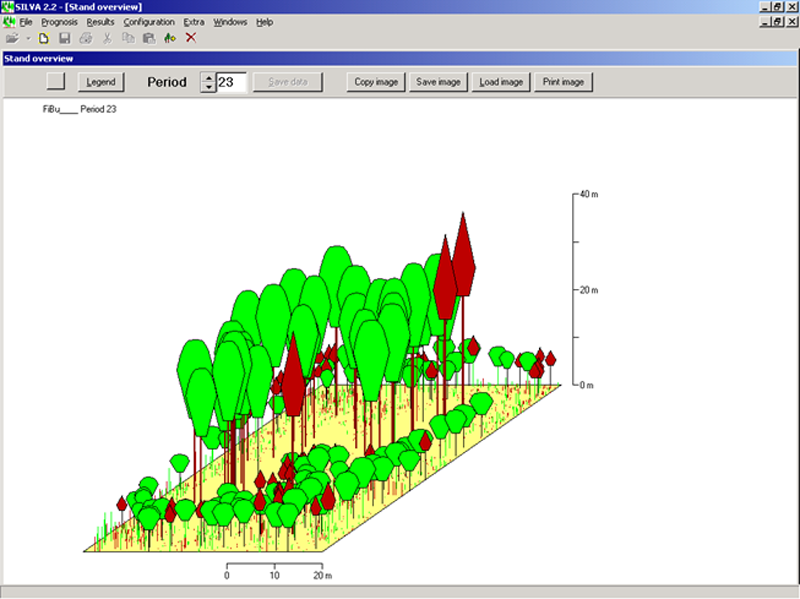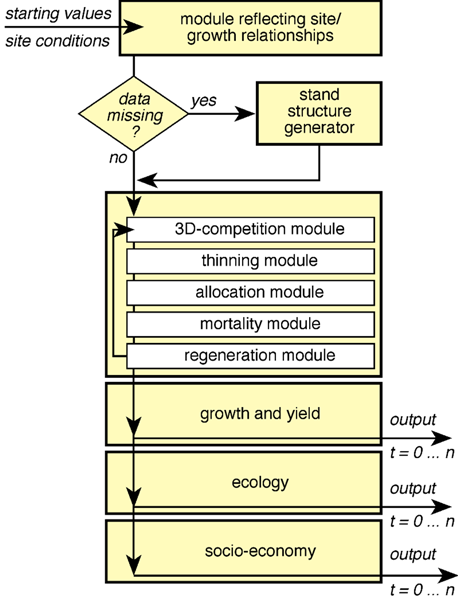SILVA

A single tree and position dependent simulator and a flexible tool for predicting the impact of various forest management regimes on forest dynamics over one generation, accommodating treatments at stand-scale and larger scales, including landscape and country-level simulations.

The SILVA simulator is a simulation tool designed to predict the impact of various forest management regimes over the course of one generation. It accommodates a wide range of treatments, providing forest managers and researchers with valuable insights into how different management strategies may affect forest dynamics. Originally developed for stand-scale applications, SILVA's flexibility allows it to be extended to larger scales, including landscape- and country-level simulations.
In OptFORESTS, we use SILVA in research to explore and assess stand-level management strategies with a wide range of silvicultural techniques to evaluate the potential effect of genetic diversity on forest productivity and resilience, due to enrichment and the variety of resulting forest structures.
Main model information
SILVA 2.0 has user friendly interface in English. SILVA 3.0 with higher potential for large-scale applications runs in C++
It can be used for:
- Single stand forest growth and yield predictions
- Test of multiple management scenarios
- Test for changes in forest structure due to species or genetic diversity
Norway spruce, Scots pine, Silver fir, European beech, Sessile and pedunculate oak, European larch and Douglas fir. Other species can be generic soft and hardwood broadleaves
Yes
Yes
Potentially all types of temperate forests
Astor Torano Caicoya
astor.torano-caicoya@tum.de
Additional model description
- Distant dependent tree growth model
- Growth response multiple 3D structures
- Mortality by competition (self-thinning) and competition risk
- 7 tree species and 2 generic groups
- Adaptation to climate change through climate scenarios
- Flexible silviculture
- Tree species and dimensions
- Tree positions (if available)
- Tree species
- Site information
- Climate scenario
- Management
- Simulation period
- Single tree dimensions
- Single tree growth and mortality
- Ecosystem services
- Growth and Yield aggregated at stand level
List of References
- Pretzsch, H., Biber, P., Ďurský, J. (2002). The single tree-based stand simulator SILVA: construction, application and evaluation. Forest Ecology and Management 162, 3–21. https://doi.org/10.1016/S0378-1127(02)00047-6
- Mette, T., Albrecht, A., Ammer, C., Biber, P., Kohnle, U., Pretzsch, H. (2009). Evaluation of the forest growth simulator SILVA on dominant trees in mature mixed Silver fir–Norway spruce stands in South-West Germany. Ecological Modelling 220, 1670–1680. https://doi.org/10.1016/j.ecolmodel.2009.03.018
- Toraño Caicoya, A., Biber, P., Poschenrieder, W., Schwaiger, F., Pretzsch, H. (2018). Forestry projections for species diversity-oriented management: an example from Central Europe. Ecological Processes 7, 23.
- Caicoya, A.T., Poschenrieder, W., Blattert, C., Eyvindson, K., Hartikainen, M., Burgas, D., Mönkkönen, M., Uhl, E., Vergarechea, M., Pretzsch, H. (2023). Sectoral policies as drivers of forest management and ecosystems services: A case study in Bavaria, Germany. Land Use Policy 130, 106673. https://doi.org/10.1016/j.landusepol.2023.106673
- Biber, P., Borges, J.G., Moshammer, R., Barreiro, S., Botequim, B., Brodrechtová, Y., Brukas, V., Chirici, G., Cordero-Debets, R., Corrigan, E., Eriksson, L.O., Favero, M., Galev, E., Garcia-Gonzalo, J., Hengeveld, G., Kavaliauskas, M., Marchetti, M., Marques, S., Mozgeris, G., Navrátil, R., Nieuwenhuis, M., Orazio, C., Paligorov, I., Pettenella, D., Sedmák, R., Smreček, R., Stanislovaitis, A., Tomé, M., Trubins, R., Tuček, J., Vizzarri, M., Wallin, I., Pretzsch, H., Sallnäs, O. (2015). How Sensitive Are Ecosystem Services in European Forest Landscapes to Silvicultural Treatment? Forests 6, 1666–1695. https://doi.org/10.3390/f6051666

